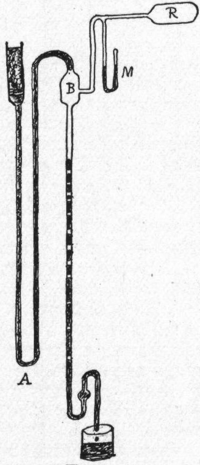- Sprengel pump
-
 The supply of mercury is contained in the reservoir on the left. It flows over into the bulb B, where it falls in drops into the long tube on the right. These drops entrap between them the air in B. The mercury which runs out is collected and poured back into reservoir on the left. In this manner practically all the air can be removed from the bulb B, and hence from any vessel R, which may be connected with B. At M is a manometer which indicates the pressure in the vessel R, which is being exhausted. A pump of this type is capable of producing a vacuum in which the pressure is only 100,000,000th of an atmosphere.[1]
The supply of mercury is contained in the reservoir on the left. It flows over into the bulb B, where it falls in drops into the long tube on the right. These drops entrap between them the air in B. The mercury which runs out is collected and poured back into reservoir on the left. In this manner practically all the air can be removed from the bulb B, and hence from any vessel R, which may be connected with B. At M is a manometer which indicates the pressure in the vessel R, which is being exhausted. A pump of this type is capable of producing a vacuum in which the pressure is only 100,000,000th of an atmosphere.[1]
The Sprengel pump is a vacuum pump invented by Hanover-born chemist Hermann Sprengel in 1865 while he was working in London. The pump created the highest vacuum achievable at that time.
The system used drops of mercury falling through a small-bore capillary tube to trap air from the system to be evacuated. The falling mercury drops compressed the air to atmospheric pressure which was released when the stream reached a container at the bottom of the tube. As the pressure dropped, the cushioning effect of trapped air between the droplets diminished, so a hammering or knocking sound could be heard, accompanied by flashes of light within the evacuated vessel.
The speed, simplicity and efficiency of the Sprengel pump made it a popular device with experimenters. Sprengel's earliest model could evacuate a half litre vessel in 20 minutes[2]. The device was later found capable of reducing the pressure to less than 1 mPa. [3].
William Crookes used the pumps in series in his studies of electric discharges. William Ramsay used them to isolate the noble gases, and Joseph Swan and Thomas Edison used them to evacuate their new carbon filament lamps. The Sprengel pump was the key tool which made it possible in 1879 to sufficiently exhaust the air from a light bulb so a carbon filament incandescent electric light bulb lasted long enough to be commercially practical.[4] Sprengel himself moved on to investigating explosives and was eventually elected as a Fellow of the Royal Society.
References
- ^
 "Air Pump". The New Student's Reference Work. Chicago: F. E. Compton and Co. 1914.
"Air Pump". The New Student's Reference Work. Chicago: F. E. Compton and Co. 1914. - ^ http://www.rsc.org/chemistryworld/Issues/2008/February/ClassicKitSprengelPump.asp
- ^ http://en.wikisource.org/wiki/The_New_Student%27s_Reference_Work/Air_Pump?uselang=en
- ^ Jehl, Francis (1990). Menlo Park Reminiscences, Volume 1 (Reprint of 1937 edition with new introduction ed.). New York: Dover Publications. pp. 430 pp.. ISBN 0-486-26357-6.
Further reading
- Thompson, Silvanus Phillips (1888). The Development of the Mercurial Air-pump. London: E. & F. N. Spon. pp. 14 – 15. http://books.google.com/books?id=NNVUAAAAQAAJ&pg=PT19&dq=Hermann+Sprengel&as_brr=1#PPT4,M2.
Categories:- Vacuum pumps
- ^
Wikimedia Foundation. 2010.
